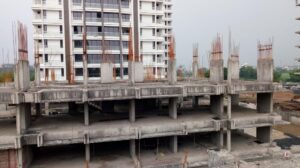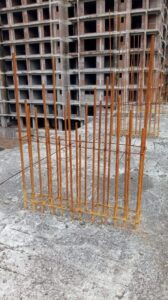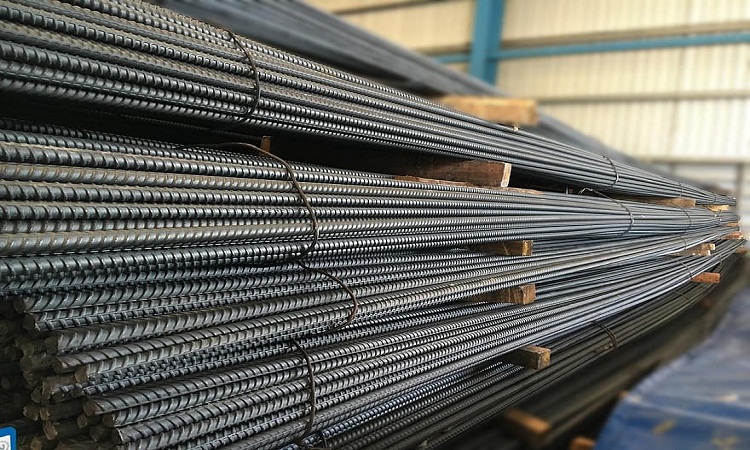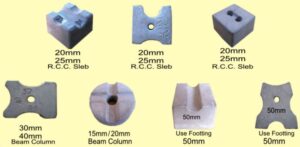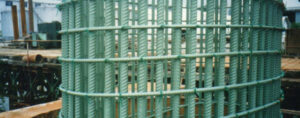Reinforcement plays a very important role in construction; it takes most of the tensile forces which are faced by reinforced concrete structures while concrete takes care of the compressive loads.
Reinforced concrete construction (RCC) faces several types of environmental attacks during its lifetime. Chemicals like sulfates and carbonate attack the concrete while chlorides and moisture (water) attack the steel in RCC. It is, therefore, necessary to take all precautions to prevent such attacks on RCC structures for high performance. The selection of the correct type and quality of steel and its procurement from a reliable source is important. The success of an RCC job depends to a large extent on the reinforcement being correctly and rigidly fixed in the concrete with the right spacing and cover. The cover to the reinforcement is extremely important for the protection of steel in concrete. The cover should not only be adequate in thickness but the concrete quality in the cover itself should be dense and well compacted.
Accurate cutting, bending, and fixing of steel bars are a must, so that correct cover is maintained and steel is adequately protected.
Bars Types and Identification
The reinforcement steel is generally available in three forms.
- Mild steel rounded bars
- High strength deformed
- Corrosion resistant steel
While the rounded mild steel bars are manufactured by hot rolling of mild steel, the high yield steel is made by either hot rolling a low alloy steel or by cold twisting and stretching of the mild steel bar.
By visual inspection the engineer can know if the bar is plain mild steel, hot rolled deformed, cold worked deformed ribbed (TOR) or cold worked twisted (TOR).
TOR steel is available in several types/grades. TOR-40 is identified by a registered trademark ‘TOR’ on every meter of bars. TOR-50 is identified by a registered trademark as stated above, plus mark a ‘50’ or ‘0’ or *(star) between the two ‘TOR’ trademarks at times at 300 mm spacing. The TOR 50 bars are also painted ‘green’ for the length of 10 cm at both ends for easy identification.
Checklist for Buying Reinforcement
- The suppliers must give bills/invoices/receipts etc. Stating TOR Torsteel only and Torsteel / CTD. The latter is an indication that Torsteel reinforcing steel bars are drawn using some percentage of lower quality CTD steel bars which are generally rolled from ingots produced of Induction Furnace. The induction Furnaces do not have the facility to refine the chemical composition of the scrap steel melted by it. Since chemical composition is an important criterion that governs the quality of reinforcement steel, it is not permitted to roll tor steel or high strength deformed steel from induction furnace, unlike others.
- Tor/Tor steel is manufactured by authorized licensees under the supervision of Tor–Allis Engineering Services Pvt. Ltd. The test certificate from such licenses must mention only Tor Tor-steel and nothing else. It is not recommended to procure Torsteel or high strength deformed steel from other manufacturers.
- The marking of the pitch of the twists should be as stated above. The correct pitch is an indication of good quality for Torsteel is an important criterion that governs the quality of reinforcement steel, it is not permitted to roll Torsteel or high strength deformed steel from induction furnace, unlike other steel.
- It is recommended to get at least one sample from every 10 MT of reinforcement steel tested in an independent laboratory.
- The rest certificate is always supplied by Torsteel licensees for any quantity of steel supplied by them. The certificates are half printed and half embossed (readable). This prevents steel suppliers from passing on CTD bars as Tor reinforcement by supplying Xerox copies.
Production of Ideal Reinforcing Steel
The still making aspect has recently attracted some attention for improving the quality because of the use of Induction Furnace ingots. The induction furnace is used for melting steel but is cannot be used for refining still. The quality of steel produced using the induction furnace is as good or as bad as the steel (generally scrap steel) used as raw material into the induction furnace. Scrap steel, as it is generally called and as the name implies, is not necessarily good steel. Hence steel is produced by melting scrap steel in the induction furnace will be of identical quality to that of steel fed into the furnace. It is, therefore, important, to refine the steel and produce consistent quality steel, independent of the raw material used. It is not possible to achieve this in an induction furnace.
Refining facilities such as refining ladle, systems, etc. are required to change the chemistry of the raw materials to get a correct end product. Carbon and manganese are added to improve strength. However, they have to be within limits to guarantee easy weldability. Sulfur and phosphorous have to be limited to avoid brittleness in the hot and cold states. The use of stray or tramp elements like lead, copper, and tin should be controlled and minimized as far as possible.
The size of raw material feed is also important in relation to the diameter of the finished bar. A certain minimum reduction is required to ensure good and uniform physical properties in the finished bars.
Just as the chemistry and size of raw materials are required to be controlled, the heating process also needs proper control. The temperature of heating and the duration in the reheating furnace need proper control depending on the type of furnace. The required temperature should be throughout the cross-section and not just at the surface. Care should be taken, that both time and temperature are controlled, because overheating may be equally harmful.
The steel heated/soaked at the right temperature is then rolled by carefully scheduling the hot rolling. The final pass, where most reduction takes place and finishing temperatures are important, needs proper monitoring.
Lower finishing temperatures (down to 750oC ) give better properties to the steel bars but will also require more power to drive the rolls, therefore, the engineering parameter can influence the cost of production considerably. Cooling water must be supplied to the rolls for longer roll life and also for better product quality. It is also essential that the grooves are cut on the rolls accurately so that the material emerging from each roll stand is of the desired shape. Finishing rolls are most important as the final geometry of the bars depends on the accuracy with which the grooves are cut in the workshop.
The quality of reinforcement steel produced will depend on many other controls involved in the complex process. However, some of them would be of interest to the end-users and are given below.
- Proper tension between various stands and the pinch roll pressure must be controlled. The pull must be sufficient to create enough pressure but should not exceed so as to leave any marks on the relatively soft red hot bar.
- The worn-out grooves must be properly maintained or remachined before starting a new rolling schedule. Irregularities in the grooves can be checked in the normal course of production by checking half-hourly samples for the geometry of ribs and lugs and to ensure that the weight per meter is within the specified rolling margins.
- The twisting of bars requires proper control. Proper cooling is necessary before twisting is undertaken. The bar has to be kept taut so that cold work will be reasonably uniform. In cold twisting, there are several advantages. Raw material faults like surface defects are easily detected and mostly rectified by surface grinding. The less amenable defects like segregations, blowholes, and piping may not be visible to the naked eye as the mechanism of metal solidification is such that, these defects are least on the outer surface of the billets.
- When old twisting is done, the bar is subjected to very severe mechanical stress, the material is deformed into the plastic range and any significant invisible defect will cause the bar to fracture during the twisting itself.
- The optimum pitch of twisting required to achieve the specified physical properties depends on the raw material, size, and chemistry. Twisting is determined in a systematic manner by trial twisting from each batch and assessing the test results.
Site Arrangements
The work of storing, cutting, bending, and fixing reinforcement becomes easier with proper planning and careful selection of storage and working area. The requirement will differ from job to job depending on the quantum of work and whether or not all the above activities are to be executed at the site.
Storage
The points to be borne in mind regarding storage are as follows:
- The bars must be laid, so that the correct type, size, and length are located easily without double handling.
- The bars must not get contaminated by materials like mud, oil, and grease.
- The bars should be stored on a raised platform or wooden sleeper/precast concrete supports, so that, they do not get contaminated with mud, water, moisture, or humidity and start rusting. The supports should lose enough so that, bars do not develop a band on account of improper storage. In addition, a suitable all-around protective cover of polythene sheeting is preferred and it remarkably improves the performance of reinforcement steel as it prevents rusting to a great extent during storage.
- Long storage periods especially in high humidity conditions and monsoon periods should be avoided. Alternatively, steel reinforcement must be properly covered and protected from rain and moisture.
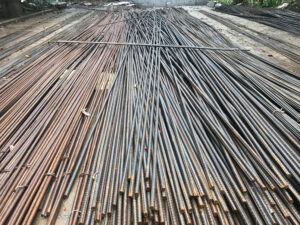
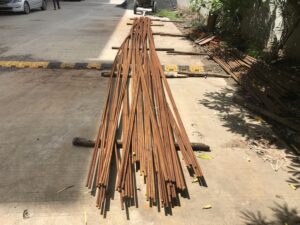
Cutting and Bending
Generally, in our country, and bending of steel bars is done manually. Even coiled steel is straightened manually at the site. Equipment is now easily available for cutting, bending, and straightening reinforcement steel. The job can be done must faster, giving better quality and economy.
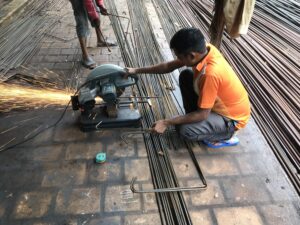
The cutting area should be as close to the storing area as far as possible.
So that handling is simple and does not require long leads to transport. The handling of the bars had to be done properly and carefully during each and every operation. Avoid throwing the bars as bends and kinks will develop at undesired locations which will be difficult to straighten at a later stage.
Before cutting, the bars should be correctly selected. The type of steel, diameter, and length should be properly checked and verified. Proper planning of cutting schedules is necessary. This can prevent unnecessary wastage and scrap formation.
It is recommended to use steel tapes for measuring bars as there are fewer chances of an error when steel taps are used.
The cutting length must be properly established from the bar bending schedules. This is extremely necessary when bars required for stirrups are cut. If the length cut is short, then the stirrups may not fit properly or may create problems of increased cover or decreased effective depth. Similarly, if the length cut is more, then the stirrup will be fixed in a skew manner and result in less cover or congestion of reinforcement at certain locations.
Bending should be carried out with proper machines whether hand operated or powered. The use of manual makeshift methods will produce poor results and are dangerous.
Some precautions required for bending are listed below:
- Before bending a large complicated bar shape, prepare a full-scale drawing that can be used for checking or alternately prepare a jig or gauge for checking bar diameters and shapes before cutting and bending. Visual identification of bar sizes should be avoided.
- Bending machines or jigs may cause variations, so before bending a number of bars with several bends, especially with critical dimensions, the first finished bar should be properly checked to see that it is of correct dimensions.
- Check the diameter of the mandrel before bending. The inside radius of the bend should not exceed ‘2d’ for mild steel bars and ‘3d’ for high – yield bars (‘d’ being bar diameter). Too tight a radius will break weaken the bar.
- Always bend high – yield bars cold. Mild steel bars of large diameter may be heated to a cherry red heat but must not be quenched in water to cool them.
- During cold weather, the speed of bending be reduced for high–yield bars as steel becomes more brittle below 5oC. This reduced speed of bending also applies to dowel bars that have been bent already and require straightening. Bending of high–yield steel bars by 90o for the diameter above the 10mm for the dowels is generally not recommended as at a later stage while straightening it is likely to break.
- Make sure that the latest revision of drawings and schedules are available and referred. Superseded drawings and schedules must be destroyed once revisions are received at the site.
- The bar to be bent must be properly gripped while being bent. If support is not firm then the bar may bend in the wrong place.
- Cut and bend bars must be bundled and labeled before stacking so that fitters can easily spot them and fix them at the correct location. Each bundle should not weigh more than 75kg, it should have bars of identical shape and size, and have a label that indicates the length, size, shape, and type of bar used.
Cleanliness and Rust
The reinforced concrete structure is a composite mass whose performance greatly depends on the bond between the steel bars and the concrete placed and compacted around them. The quality of the bond will greatly depend on the cleanliness of the steel bar surface and the quality of concrete around it. It is, therefore absolutely necessary that bar surfaces are free from grease, oil, mud, mould oil, loose mill scales, excessive rust, loose concrete, and/or ice.
It is also recommended not to leave the steel bars exposed for a long period of time (more than two weeks) after they are fixed. This will cause rusting of steel and subsequent staining of concrete.
The effect of rust on the bond between steel and concrete is often a debatable issue on site. A little rust or brownish tinge on the bar is not harmful to reinforced concrete. However, loose mill scales or excess flaky rust must be removed by firm tapping or scraping. Reinforcement steel, before it is placed and embedded in concrete, reacts with oxygen and moisture in the atmosphere while it is being transported and stored. This causes the formation of a thin film of rust which is reddish-brown in color. This reddish-brown film, so long as it is skin deep, is considered desirable.
This brownish coating is said to improve bond quality and is not easily removable even after wire brushing or scraping. The brownish tinge can remain and it needs not to be removed. Besides improved bond quality, this thin brownish film on the surface of the reinforcement also offers passivation to the steel surface against corrosion.
Steel that is stored for a long period of time also needs to be checked for cleanliness and excessive rusting before cutting and bending is done.
Fixing of Reinforcement Steel
Cover and Spacers
To protect the reinforcement from corrosion and for the composite action of the reinforcement and concrete to be effective, it is absolutely necessary for the steel bars to be surrounded by sufficiently impermeable strong concrete. If moisture and chlorides penetrate into concrete the steel bars will rust and due to the formation of ferrous oxide or ferrous hydroxide, there will be an expansion in the volume of steel nearly 7 to 8 times its original size. This increase in the volume of steel creates tensile forces in concrete and exposes the concrete to further attack.
All reinforcement steel has to be embedded to a certain minimum distance from the surface. This distance is called ‘cover’ and is specified by the structural Engineer, in the drawings, depending on the following factors:
- Quality and grade of concrete.
- The environment in which concrete is located.
- The thickness of the structure and its location.
- Special provision to resist fire.
The correct cover is achieved by using mortar or plastic blocks/shapes. Generally, cover blocks at the site are made out of the mortar, without proper compaction or using correct size moulds. These results in porous cover blocks of low strength which instead of protecting steel against ingress of moisture and/or other harmful chemicals give an easy passage causing rusting of steel and spalling of concrete. The mortar blocks should be of good strength (in the range of main concrete). They should also be well cured and most important; they should be dense and well compacted. Similarly, plastic covers of poor quality often break as they are not made from good quality special plastic.
It is important to use the correct size cover blocks to give the required depth of protection to steel reinforcement. The cover blocks should be spaced at the correct distance to ensure adequate and uniform protection to steel reinforcement throughout. It is equally important to provide adequate cover to both, main reinforcement as well as stirrups and ties which generally project beyond the main reinforcement.
Mortar cover blocks are best made using cement mortar in 1:2 cement to sand proportion, and water is added just sufficient enough to give dense concrete with low permeability. Adequate precaution must be taken so that any wire cast into the blocks is kept away from the exposed surface. If this is not done there will be a risk of rusting or rust stains on the concrete surface.
Metal spacers should not be used when the structure is located in a corrosive environment or is in contact with water. Do not use the stone chip or timber pieces as permanent covers/spacers.
The top and bottom reinforcement in suspended slabs have to be placed and fixed correctly before concrete placing starts. They have to be properly secured so that they are not displaced changing the effective depth and cover at the top and bottom. Smaller cover blocks have to be used bottom. Mild steel chairs of adequate size, the shape must be placed at such spacing that it can carry the top steel and keep the required effective depth between the top and bottom steel, uniformly and correctly. The cover blocks at the bottom of the steel cage should be strong enough to take the foot load of workers.
In cantilever slabs, due to inadequate cover, it is observed that the top reinforcement shifts to the bottom due to poor fixing and movement of workers over the bars during the concrete placing and compacting process. This often results in failures, as the steel which is required at the top of the slab to take up the required tensile forces and moments collapses or settles below due to the reasons given above.
In the case of the slabs on grade which are singly reinforced, it is often convenient to place the concrete up to a given level and then place the steel bars or steel fabric before placing the rest of the concrete above the steel.
Never attempt to place the reinforcement age on the formwork and later try to raise it as the concrete is being placed. This will never give the correct cover of effective depth.
If spacers are allowed on the face of a beam or wall but not on the opposite face, the reinforcing cage must be held in position by pulling it towards the formwork on one side by means of wires attached to the cage and passing through holes in the formwork. The wires are pulled towards the formwork so that the spacers on this side prevent reinforcement from actually touching the formwork, thereby giving a correct cover. This will also ensure proper cover on the side without spacers. However, all wires must be removed soon after concrete is placed or it will cause rust strains and future durability problems.
Recommendations for Cover
Some guidelines for providing cover to steel reinforcements given below can be followed if not indicated in drawings:
- For cover in beams, more than 25mm or more than the diameter of the main reinforcement bar whichever is higher.
- For a longitudinal bar in a column, more than 40mm or more than the diameter of the bar if it is higher than 40mm.
- In slab or wall or for any other slender members more than 13mm or more than the diameter of reinforcement whichever is higher.
- For footings, pile foundations, and other massive structural members, cover to bottom and side reinforcement at least 75mm.
- For surfaces exposed to moisture or groundwater after removal of form, more than 50mm for bars larger than 16mm diameter, more than 40mm for bars smaller than 16mm diameter.
- For reinforcement concrete members totally or periodically immersed in sea or subject to seawater spray, cover shall be 50mm more than under case (a) and (c) given above.
- For liquid retaining structure, the cover will be 40mm or equal to the diameter of the bar whichever is greater. For structures in seawater, it should be 10mm more than for structures in sweet water.
Protection of steel bars when work is suspended for a long period
It is often observed that reinforced concrete construction is done in a phased manner. As a result dowel bars left in the first phase have to be protected till such time the second phase is taken up. The protection can be done in the following manner.
- Apply a firm cost of the neat cement slurry to the exposed reinforcement bars leaving no point untouched.
- Apply suitable anti-corrosive chemicals to guard against corrosion.
- Encase the dowel bars in concrete either partly or fully.
Prior to the commencement of the second phase, the temporary protective cover has to be removed completely and the reinforcement steel surface cleaned and made free from the protective layer. At times it is observed that reinforcement is badly corroded at the junction with concrete due to abrupt change from alkaline to the acidic environment leading to the necking of steel. This should be avoided and if observed, an additional concrete surface will have to be removed and a proper bond with the desired locking/anchoring has to be provided. Some methods are available to remedy this problem. One such method is by drilling holes. The holes are cleaned and epoxy dipped reinforcement is inserted into the concrete. The reinforcement bars are subjected to tensile/pullout tests and have proved successful. The proper drilling techniques also do not damage the concrete.
